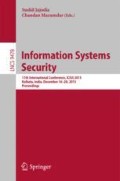Abstract
Web application firewalls (WAFs) are the primary front-end protection mechanism for Internet-based infrastructure which is constantly under attack. This paper therefore aims to provide more insights into the performance of the most popular open-source WAFs, including ModSecurity, WebKnight, and Guardian, which we hope will complement existing knowledge. The key contribution of this work is an in-depth approach for conducting such a study. Specifically, we combine three testing frameworks: the Imperva’s proprietary benchmark, a generic benchmark using both FuzzDB and Burp test-beds, and testing for common vulnerabilities and exposures (CVE) known exploits. Our experiments show that open source WAFs are not yet totally reliable for protecting web applications despite many advances in the field. ModSecurity appears to be the most balanced open-source solution.
Access this chapter
Tax calculation will be finalised at checkout
Purchases are for personal use only
References
Guardian. http://guardian.jumperz.net/index.html
ModSecurity. https://www.modsecurity.org/
Web Knight. https://www.aqtronix.com/?PageID=99
Balock, R., Jaffery, T.: Modern Web Application Firewalls Fingerprinting and Bypassing XSS Filters. Technical report, Rhainfosec (2013), White Paper
Bau, J., Bursztein, E., Gupta, D., Mitchell, J.: State of the art: automated black-box web application vulnerability testing. In: 2010 IEEE Symposium on Security and Privacy (SP), pp. 332–345. IEEE (2010)
Becher, M.: Web Application Firewalls. VDM Verlag, Saarbrücken (2007)
Bojinov, H., Bursztein, E., Boneh, D.: Xcs: cross channel scripting and its impact on web applications. In: Proceedings of the 16th ACM Conference on Computer and Communications Security, pp. 420–431. ACM (2009)
Cabrera, H., Krstic, G., Petrushevski, S.: CloudFlare vs Incapsula: Round 2. Technical report, Zero Science Lab (2013). http://zeroscience.mk/files/wafreport2013v2.pdf. Accessed 16 July 2015
Doupé, A., Cova, M., Vigna, G.: Why Johnny can’t pentest: an analysis of black-box web vulnerability scanners. In: Kreibich, C., Jahnke, M. (eds.) DIMVA 2010. LNCS, vol. 6201, pp. 111–131. Springer, Heidelberg (2010)
Huang, Y.W., Yu, F., Hang, C., Tsai, C.H., Lee, D.T., Kuo, S.Y.: Securing web application code by static analysis and runtime protection. In: Proceedings of the 13th International Conference on World Wide Web, pp. 40–52. ACM (2004)
Jovanovic, N., Kruegel, C., Kirda, E.: Pixy: a static analysis tool for detecting web application vulnerabilities. In: Proceedings of the IEEE Symposium on Security and Privacy. IEEE (2006)
Nguyen-Tuong, A., Guarnieri, S., Greene, D., Shirley, J., Evans, D.: Automatically hardening web applications using precise tainting. In: Sasaki, R., Qing, S., Okamoto, E., Yoshiura, H. (eds.) Proceedings of the 20th IFIP International Information Security Conference, vol. 181, pp. 295–307. Springer, US (2005)
Tibom, P.: Incapsula vs. CloudFlare: Security Review & Comparison. Technical report, Personal Review (2012). https://www.computerscience.se/downloads/Full-Review.pdf. Accessed 16 July 2015
Torrano-Gimenez, C., Perez-Villegas, A., Alvarez, G.: A self-learning anomaly-based web application firewall. In: Herrero, Á., Gastaldo, P., Zunino, R., Corchado, E. (eds.) Proceedings of the Conference on Computational Intelligence in Security for Information Systems, vol. 63, pp. 85–92. Springer, Heidelberg (2009)
Vernotte, A., Dadeau, F., Lebeau, F., Legeard, B., Peureux, F., Piat, F.: Efficient detection of multi-step cross-site scripting vulnerabilities. In: Prakash, A., Shyamasundar, R. (eds.) ICISS 2014. LNCS, vol. 8880, pp. 358–377. Springer, Heidelberg (2014)
Author information
Authors and Affiliations
Corresponding author
Editor information
Editors and Affiliations
Rights and permissions
Copyright information
© 2015 Springer International Publishing Switzerland
About this paper
Cite this paper
Prandl, S., Lazarescu, M., Pham, DS. (2015). A Study of Web Application Firewall Solutions. In: Jajoda, S., Mazumdar, C. (eds) Information Systems Security. ICISS 2015. Lecture Notes in Computer Science(), vol 9478. Springer, Cham. https://doi.org/10.1007/978-3-319-26961-0_29
Download citation
DOI: https://doi.org/10.1007/978-3-319-26961-0_29
Published:
Publisher Name: Springer, Cham
Print ISBN: 978-3-319-26960-3
Online ISBN: 978-3-319-26961-0
eBook Packages: Computer ScienceComputer Science (R0)

